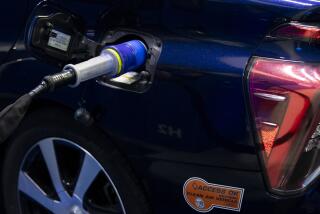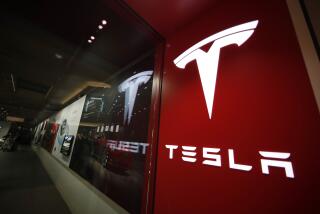Toyota admits deceiving consumers; $1.2-billion penalty is record

Toyota has agreed to pay a $1.2-billion fine in a settlement with the U.S. government, ending a four-year federal criminal investigation.
- Share via
In a landmark settlement of criminal charges, Toyota Motor Corp. admitted deceiving regulators about deadly safety defects and agreed to pay $1.2 billion, the largest penalty ever imposed on an automaker.
In the unprecedented deal with the U.S. Justice Department, the world’s largest automaker admitted it misled consumers about two defects that caused unintended sudden-acceleration incidents — sticking gas pedals and floor mats trapping the pedals.
“Toyota put sales over safety, and profit over principle,” said George Venizelos, assistant director of the FBI. “The disregard Toyota had for the safety of the public was outrageous. Not only did Toyota fail to recall cars with problem parts, they continued to manufacture new cars with the same parts they knew were deadly.”
The agreement underscores a new era of aggressive crackdowns on automakers accused of covering up safety concerns, with criminal charges as the primary deterrent. As prosecutors embark on a new criminal inquiry into delayed recalls by General Motors, the Toyota settlement hands safety advocates two hard-won victories — unlimited criminal and civil penalties.
The criminal investigation resulted in a fine that’s 35 times the maximum penalty that the National Highway Traffic Safety Administration can levy against an automaker.
“That will change their behavior far more than a civil penalty ever will,” said Clarence Ditlow, executive director for the Center for Auto Safety. “It is a game changer.”
Prosecutors also forced Toyota into a rare agreement not to claim the settlement as a tax-deductible expense. That will save taxpayers an estimated $420 million, according to the U.S. Public Interest Research Group.
Federal officials said the settlement proceeds will go into a general “asset forfeiture” fund at the Justice Department and that people who believe they were hurt by Toyota’s actions could apply for compensation.
The settlement brings Toyota’s tab for the sudden-acceleration ordeal to about $5 billion in fines, settlements, repair costs and lost sales. To be sure, Toyota can afford to pay: The automaker is expected to announce a profit of nearly $19 billion for the fiscal year ending March 31.
Toyota was formally charged with one count of wire fraud, which will be dismissed after three years if the automaker abides by the settlement terms. Prosecutors typically charge wire fraud in cases in which they suspect the use of phones, email and other electronic communications for criminal purposes.
“Entering this agreement, while difficult, is a major step toward putting this unfortunate chapter behind us,” said Christopher P. Reynolds, chief legal officer of Toyota Motor North America. “In the more than four years since these recalls, we have gone back to basics at Toyota to put our customers first.”
Reynolds said the automaker has improved quality control by responding more quickly to customer concerns and giving more autonomy to regional managers.
Toyota’s lengthy history of sudden acceleration was the subject of a series of Los Angeles Times articles in 2009, after a horrific crash outside San Diego that took the life of an off-duty California Highway Patrol officer and his family.
The Times reports examined the long history of sudden acceleration in Toyota vehicles and the growth of the problem after the automaker moved to electronic throttle systems.
Toyota, which has blamed the problem on mechanical rather than electronic issues, said the acceleration issues are responsible for five documented deaths. But the Center for Auto Safety estimates that the problem has caused hundreds of fatalities and injuries.
Prosecutors said Toyota executed a “campaign of disinformation” to fool regulators and consumers about the depth of the safety problems.
Toyota “cared more about savings than safety, because it cared more about its own brand and bottom line than the truth,” U.S. Atty. Preet Bharara said.
As far back as 2007, Toyota knew that its gas pedals could become stuck under floor mats and had internal reports that identified design problems, prosecutors said. But Toyota resisted recall suggestions, instead negotiating with the National Highway Traffic Safety Administration to call back only a limited number of extra-thick all-weather floor mats rather than actual vehicles.
“Toyota was positively jubilant about that result, noting in an internal email that it had saved ‘$100 million plus in unnecessary costs,’” Bharara said.
That agreement paved the way for the 100-mph crash of the Toyota-built Lexus ES that killed the Highway Patrol officer and his family, Bharara said. Investigators believe the sedan went out of control after a floor mat jammed the gas pedal in the open position, but the car was too badly damaged to know for sure.
Following the crash, Toyota recalled eight models that NHTSA said had floor mat problems, but the automaker failed to recall three other models — including the popular Corolla — even though Toyota engineers knew they were vulnerable, prosecutors said.
“So the truth is that Toyota hadn’t fully addressed the problem after all, despite all the public pronouncements,” Bharara said.
Toyota admitted in the settlement that it pursued a similar strategy in handling related problems with a gas pedal mechanism that could make the accelerator stick.
The automaker kept that issue hidden from U.S. regulators even though it had ordered a design change for cars in Europe and had scheduled a fix for U.S. cars as an “urgent” measure, the U.S. attorney said.
“In the midst of the firestorm over the San Diego accident and unwanted acceleration problems, what did Toyota do? It quietly canceled the ‘sticky pedal’ fix in America,” he said. “Toyota executives directed employees not to put anything about the cancellation in writing and to avoid a paper trail.”
Analysts say General Motors Co. has kept an eye on Toyota as it faces its own crisis. GM is now under fire for waiting a decade to recall cars that have an ignition switch problem linked to at least 12 deaths. It’s clear that GM took lessons from Toyota’s early resistance to taking responsibility for safety defects.
“We are deeply sorry for the lives lost and the lives it has affected,” Mary Barra, GM’s chief executive, said this week. “This issue goes back 10 years, but I take full responsibility for resolving it for our customers, our employees and the authorities.”
Toyota still faces a Securities and Exchange Commission investigation, according to a regulatory filing the automaker made last year. Meanwhile, Toyota’s lawyers are in settlement talks over hundreds of civil lawsuits alleging wrongful deaths or injuries.
Previously, Toyota agreed to pay $1.6 billion to settle a class-action case brought by thousands of Toyota owners who contended that sudden-acceleration problems damaged the value of their vehicles. Previously, Toyota has said recalls to fix the vehicles cost about $1.1 billion and that fallout from the problems created about $880 million in lost sales.
Throughout the ordeal, Toyota has maintained that there was no electronic flaw that might cause its cars to accelerate unexpectedly. Toyota has blamed such incidents on three possible causes: drivers mistaking the gas pedal for the brake; gas pedals getting stuck under floor mats; or sticky gas pedals that don’t throttle back quickly as foot pressure eases. NHTSA has linked at least 39 deaths to pedal mistakes.
A 10-month investigation, conducted primarily by NASA engineers, found no evidence that electronic defects or software code errors could have caused the thousands of sudden-acceleration incidents reported over the last decade. That review blamed the incidents on the same mechanical issues identified by Toyota.
Last year, however, an Oklahoma City jury found that faulty electronic systems caused a Camry sedan to suddenly accelerate and crash, killing one woman and injuring another.
“The settlement with the Justice Department focuses on a narrow area — what they disclosed on floor issues and sticky pedals,” said Sean Kane, president of Safety Research & Strategies. “But it still doesn’t get to what Toyota knew about the vehicle electronics.”
[email protected] Twitter @latimesjerry







